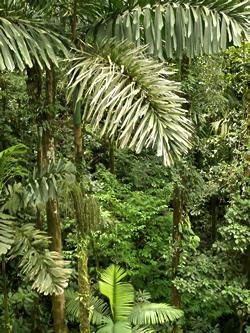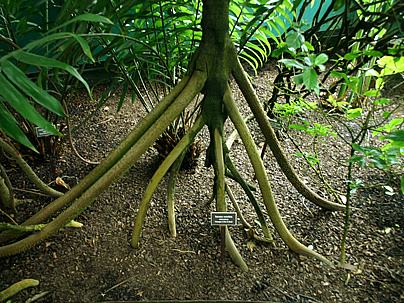The Walking Palm (Socratea exorrhiza) is a species of dioecious and elegant palm native to the Amazon rainforest, drawing attention due to the unique shape of its trunk and roots, which give it a curious appearance and spark many theories about their function. Its canopy is light, with pinnate leaves, feather-like and full, reaching approximately 2 meters in length.
The leaflets are uneven with serrated margins, light green with bluish sheaths covering the heart of the palm. Inflorescences emerge at the base of the leaves, branching out, measuring 20 to 40 cm in length, with numerous small cream-yellow flowers, pollinated by beetles. The resulting fruits are ellipsoidal drupes, turning reddish-brown when ripe, highly prized by birds.
The seed is large and resembles a nutmeg seed with contrasting veins. It features a single, erect, and cylindrical stem that, despite being slender, around 10 to 20 cm in diameter, can reach a height of 20 meters. At its base, the trunk takes on a cone shape and is supported by strong adventitious roots, covered in white thorns, causing the base to often hover without touching the ground.

With a bit of imagination, one might easily get the impression that these roots act as legs, lifting and moving the trunk forward on the ground. However, there are many theories surrounding the curious form of this palm. One theory suggests that the plant does, in a way, “walk” across the terrain in search of light, to escape the shadow of a tree, for example. Still, it wouldn’t actually lift and stroll around.
The idea is that the brighter side would produce new roots, while the darker side might lose some. Throughout its life, it would move at most about a meter. Another theory is that the aerial roots serve as an adaptation to waterlogged areas, common in the Amazon.
However, one of the most accepted ideas is that the broad base of roots provides better support for its slender trunk, allowing the plant to reach light with the least energy expenditure possible—meaning more quickly than other palms—without the need to increase the diameter of the trunk or expand underground roots.
With all its eccentricity, the walking palm gains the status of a sculptural plant. Suitable for tropical and contemporary gardens, plant it individually or in small groups, with low ground cover or in lawns, so that the roots are clearly visible and can be admired by onlookers. Its use in pots is also interesting, as the roots often extend beyond the edges, creating an intriguing effect. It is low-maintenance and grows rapidly.
It should be cultivated in full sun or partial shade, in fertile soil enriched with organic matter, and regularly irrigated. It thrives in warm and humid climates, free of frost, for optimal development. However, it can be grown in pots within greenhouses during winter in temperate climates. Fertilize with palm-specific fertilizers. Propagate through seeds, freshly collected from mature fruits and immediately placed to germinate in sandy substrate kept moist.


